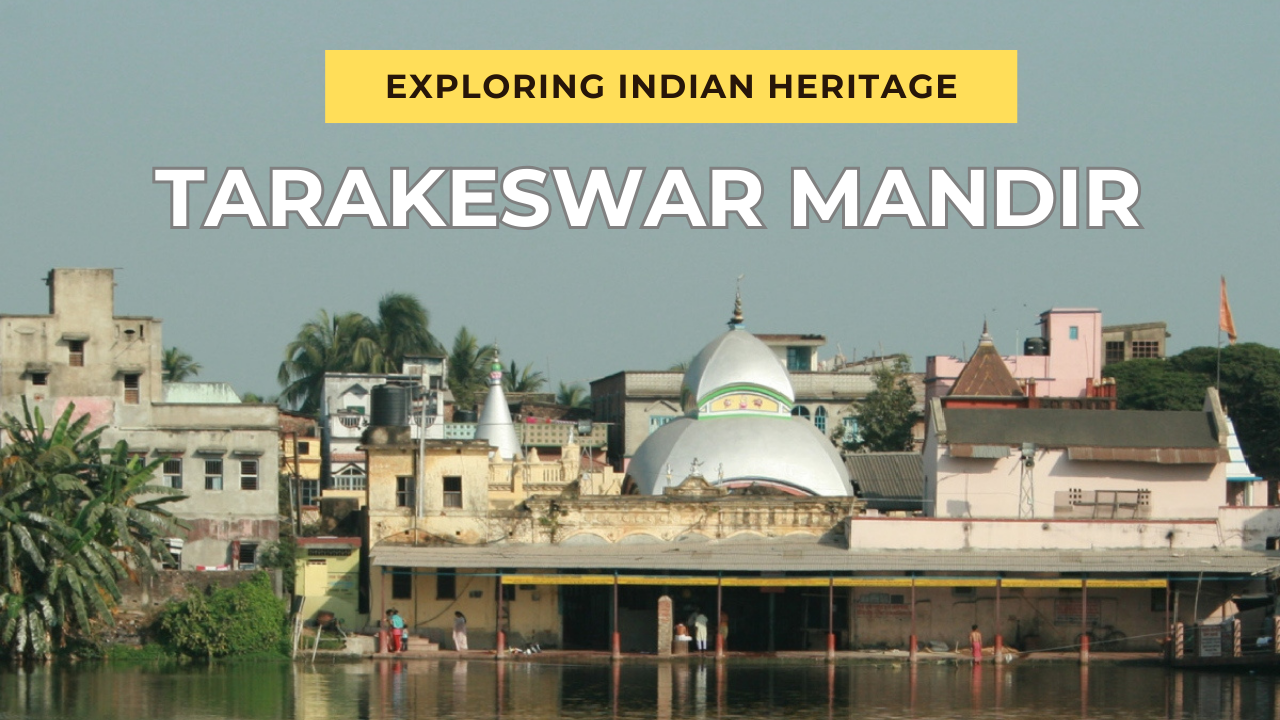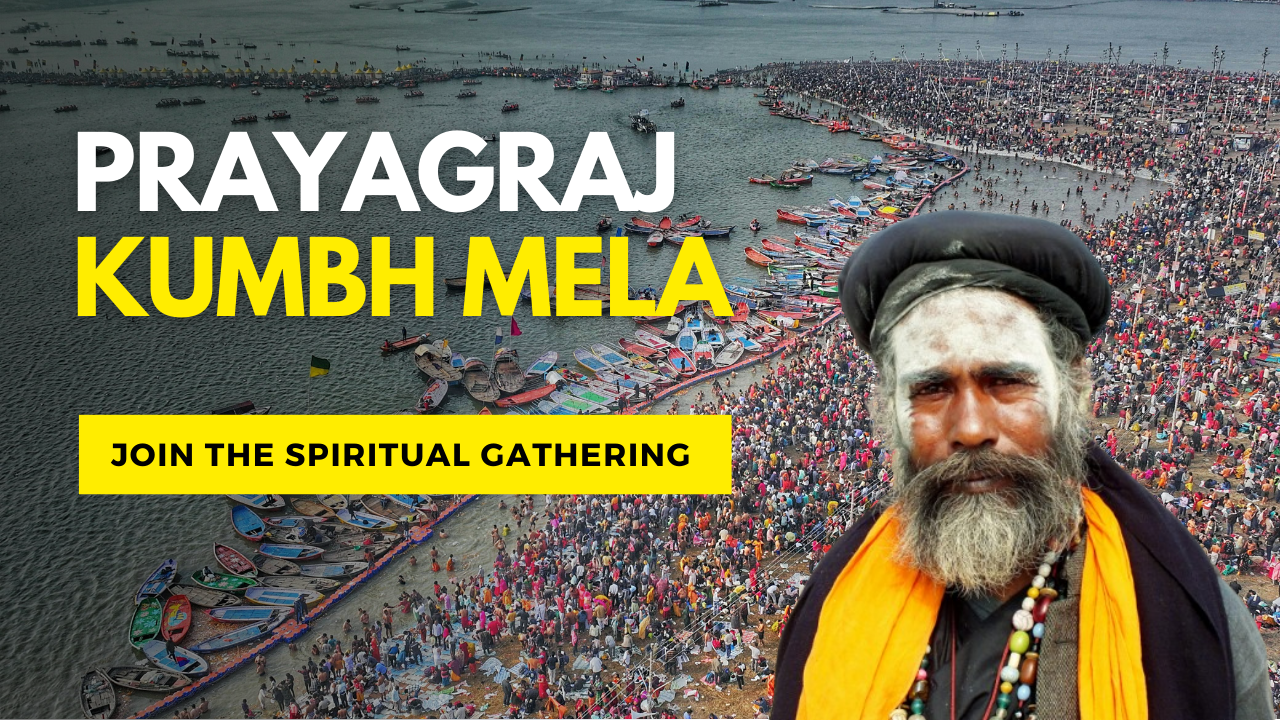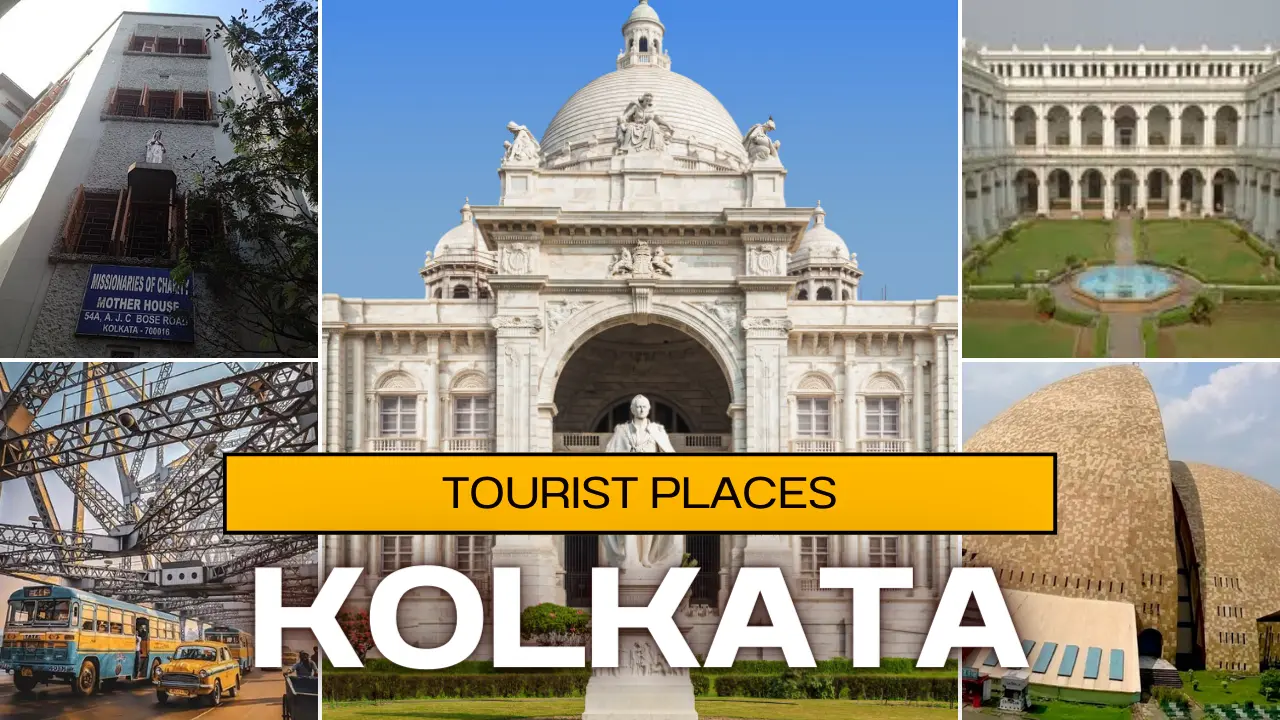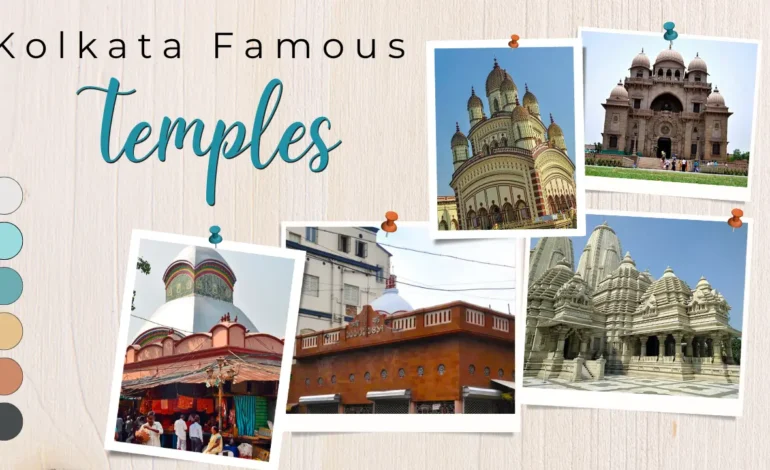
Kolkata Famous Temple: Explore the Most Iconic Temples
Table of Contents
ToggleAbout: Kolkata Famous Temple
Kolkata, a dynamic city in West Bengal, is celebrated for its deep cultural heritage and profound spiritual essence, which shines through its renowned temples. These temples are not just places of worship but also repositories of centuries-old history, tradition, and remarkable architectural craftsmanship.
The architectural legacy of Kolkata’s temples traces its origins to ancient times, incorporating influences from notable dynasties such as the Palas, Guptas, and Senas. Over the centuries, the city’s temple culture evolved significantly under the patronage of Mughal emperors and subsequently the British rulers, resulting in a distinctive fusion of Hindu, Islamic, and colonial architectural elements.
Kolkata Famous Temple
1. Kalighat Temple
Kalighat Temple is a famous Kalimandir in Kolkata and one of the Hindu pilgrimage sites of 51 Shaktipeeths. This tirtha is worshiped as the Peetha Devi Dakshinakali and the Bhairava or Peetha Rakshasa deity Nakuleshwara. According to ancient Puranic legend, it is said that either four or one toes from Sati’s right foot came to rest at this shrine following her demise. According to Purana, this place is like Varanasi.
Legend has it that Brahma, Vishnu, and Shiva are situated at the three ends of the Kali field, located 2 yojans from Behala, with the Goddess herself residing in between. Various forms of the Goddess, including Bhairavi, Bagla, Matangi, Vidya, Kamala, Brahmi, Maheshwari, and Chandi, are worshipped here. Additionally, on Deepanvita Amavasya, the Goddess is revered as Mahalakshmi.
Kalighat is an ancient sacred site dedicated to Kali. Scholars suggest that the name “Calcutta” is derived from “Kalikshetra” or “Kalighat“. It is believed that the Kaligram mentioned by the Greek philosopher Ptolemy in his description of India around 2000 years ago corresponds to present-day Kalighat. Historical records also indicate that Dhanpati Saudagar, mentioned in the Chandimangal manuscript from 1100 AD, worshipped at Kalighat while crossing the Adi Ganga river with his son Shrimant.
The unique stone Kali idol at Kalighat Kalimandir is crafted in a distinctive style. The goddess’s head is adorned with a golden crown, and she has a long gold tongue that was gifted by King Indra Chandra Singh of Paik Para. Her four silver hands, initially made by Gokul Chandra Ghosal of Khidirpur, were later gilded in gold by Kali Charan Mallick. King Nabakrishna of Patiala donated a 108-gold Mund Mala in 1765, and the golden umbrella above the goddess’s head was contributed by Nepal’s commander, Jang Bahadur, along with several other gold and silver umbrellas.
Ramjoy Banerjee, grandfather of Kalimohan Banerjee from Charakdanga, gifted the four-handed Chargachi to the goddess. At the goddess’s feet rests a silver Shiva weighing 1 mana, while on her back is a 25 kg silver relief depicting rice. In her upper left hand, she holds a 2 kg gold sword, and in the lower left hand, a gold Mund. The two right hands display boon and abhaya mudras. Various wealthy individuals have also contributed numerous other gold ornaments. Additionally, one Sindhu holds the petrified limb of Sati, which remains hidden under the Brahmavedi and is not displayed to the public.
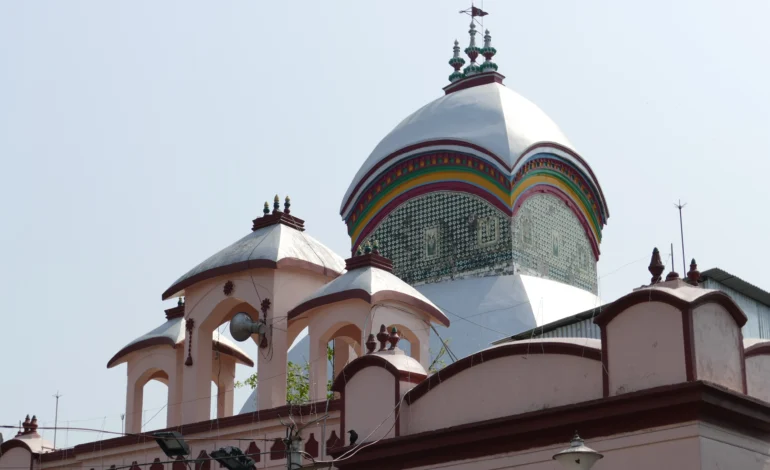
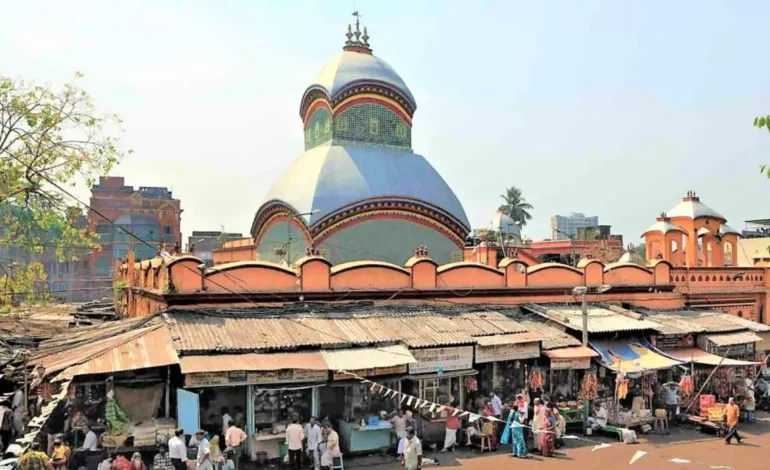
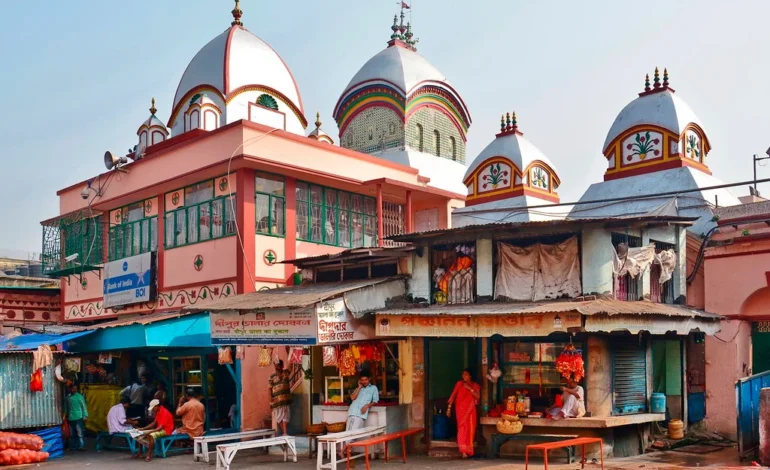

Kalighat Kali Temple Kolkata Entry Fee
- No entry fee
Kalighat Kali Temple Kolkata Timings
- Monday to Sunday 5:00 am – 2:00 pm & 5:00 pm – 10:30 pm
Address: Anami Sangha, Kalighat, Kolkata, West Bengal 700026
2. Birla Mandir
The Birla Temple is situated in Kolkata, the capital of West Bengal, India, on Ashutosh Chowdhury Road in the Ballygunge area. Constructed by the Birla family of industrialists, this temple is known for its grand celebration of Janmashtami.
Construction of this temple commenced in 1970 and spanned 26 years until its completion. The Sompura Brahmin community oversaw the construction process.
The temple was officially inaugurated by Swami Chidananda on February 21, 1998, with Karan Singh also participating in the inauguration ceremony on the same day.
Constructed on 44 kathas of land, this temple draws inspiration from the Lingaraj temple in Bhubaneswar while incorporating elements of Rajasthani temple architecture. The exterior of the temple showcases scenes from the Bhagavad Gita. Architect Nami Bose designed the temple, which features main idols of Krishna and Radha. Additionally, atop the temple, the left peak houses an idol of Durga, while the right peak displays a figure of meditating Shiva.
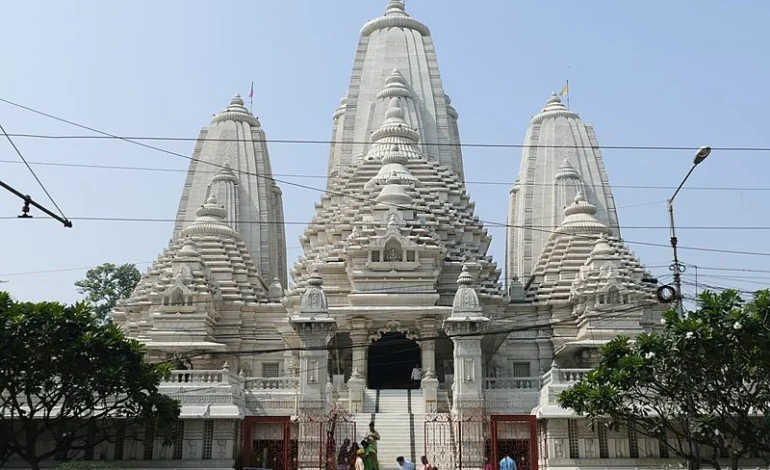
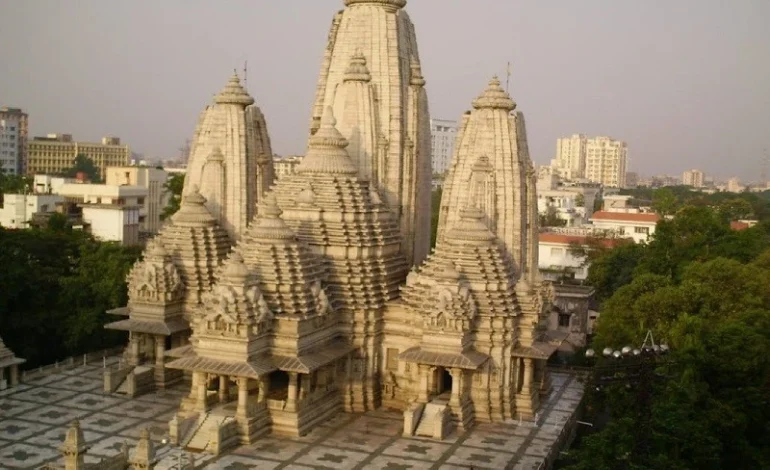

Birla Temple Kolkata Entry Fee
- No entry fee
Birla Temple Kolkata Timings
- Monday to Sunday 5:30 am – 11:00 am & 4:30 pm – 9:00 pm
Address: 29, Ashutosh Chowdary Ave, Ballygunge, Kolkata, West Bengal 700019
3. Thanthania Kalibari
Thanthaniya SriSreesiddheshwari Kalimandir, also known as Thanthaniya Kalibari, is an ancient Kali temple situated in the Thanthaniya area of Kolkata. It is located on Vidhan Sarani, just a short distance from the College Street intersection.
According to legend, in 1703 AD, a person named Udayanarayan Brahmachari crafted the idol of Siddheshwari Kali using tantric clay. In 1806 AD, Shankar Ghosh, a wealthy individual, constructed the present Kalimandir along with the Atchala Temple of Pushpeswar Shiva, and initiated daily worship. The idol of the goddess here is made of clay and undergoes renovation annually. At Thanthaniya Kalibari, Falharini puja is observed in the month of Jaishtha, Adikali puja takes place on Kartik Ambasya, and Ratanti Kali puja is performed in the month of Magha.
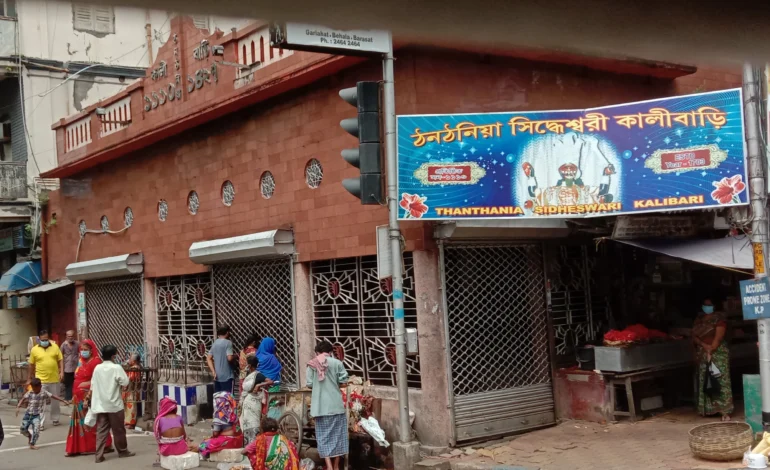
Thanthania Kalibari Kolkata Entry Fee
- No entry fee
Thanthania Kalibari Kolkata Timings
- Monday to Sunday 6:00 am - 1:00 pm & 3:00 pm - 8:00 pm
Address: Bidhan Sarani Rd, College Street Market, Machuabazar, Kolkata, West Bengal 700007
4. Dakshineshwar Temple
Dakshineshwar Kalibari is situated on the banks of the Ganges near Kolkata. Rani Rasmani, a renowned philanthropic zamindar, founded this temple on the auspicious day of Snan Yatra on May 31, 1855. The temple is dedicated to Goddess Kali, worshipped here as “Bhavtarini.” Ramakrishna Paramahamsa, a prominent nineteenth-century yogi, regularly performed Kali Sadhana at this temple.
According to legend, Rani Rasmani established the temple after receiving a divine vision from Goddess Kali. Ramkumar Chattopadhyay, the grandfather of Ramakrishna Paramahamsa, provided substantial support to the Rani during the temple’s construction and served as its first head priest. In 1857-58, Ramakrishna Paramahamsa assumed responsibility for the temple’s worship and later designated it as his principal place of spiritual practice.
In addition to the Kali Mandir, Dakshineshwar Kalibari square features several other temples and religious sites. The main attraction is the Navaratna temple, modeled after Babu Ramnath Mandal’s Navaratna temple in Taliganj. Additionally, there are twelve octagonal Shiva temples known as the “Twelfth Shiva Mandir.” Adjacent to the main temple, you’ll find the Radhakrishna Temple, also called the “Sri Sriradhakanta Temple,” to the north, and the Nata Mandir to the south. Ramakrishna Paramahamsa’s residence is located in the northwest corner of the temple premises.
Outside the main temple area, numerous memorials dedicated to Ramakrishna Paramahamsa and his family members serve as pilgrimage sites for devotees.
In 1847, Rani Rasmani, a wealthy widowed zamindar, organized a pilgrimage to Kashi to worship Goddess Annapurna. Accompanied by relatives, attendants, and supplies aboard 24 boats, they set out for the journey. Legend has it that the night before their departure, Rani had a vision of Goddess Kali, who conveyed:
“No need to travel to Kashi. Instead, worship me by establishing my idol in a beautiful temple along the banks of the Ganges. I will manifest in that form and accept your worship.”
Inspired by this divine vision, Rani Rasmani promptly purchased land by the Ganges and initiated the construction of the temple. The construction of this grand temple commenced in 1847 and concluded in 1855.
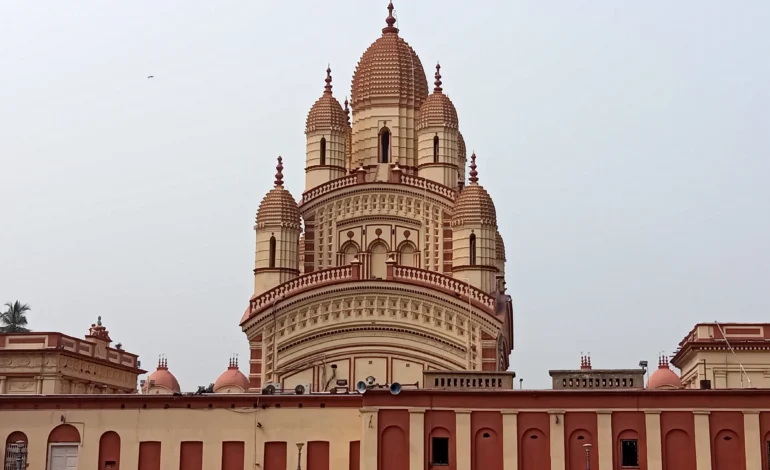
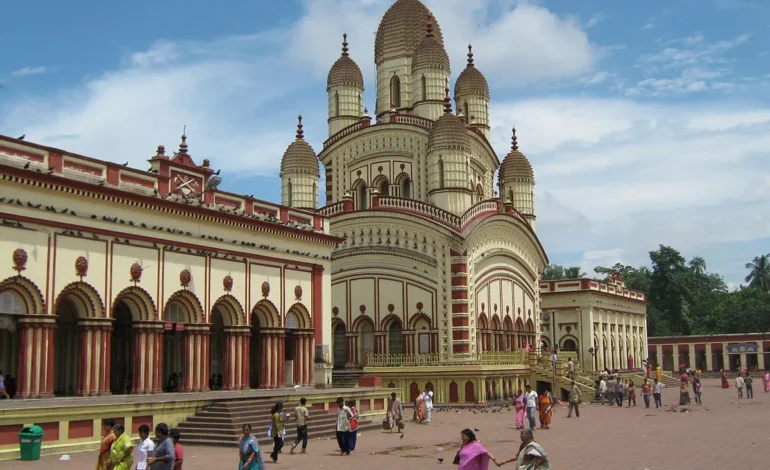
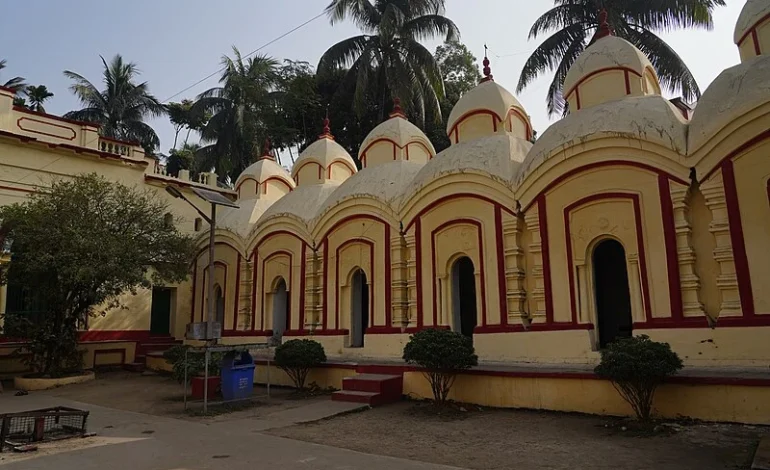
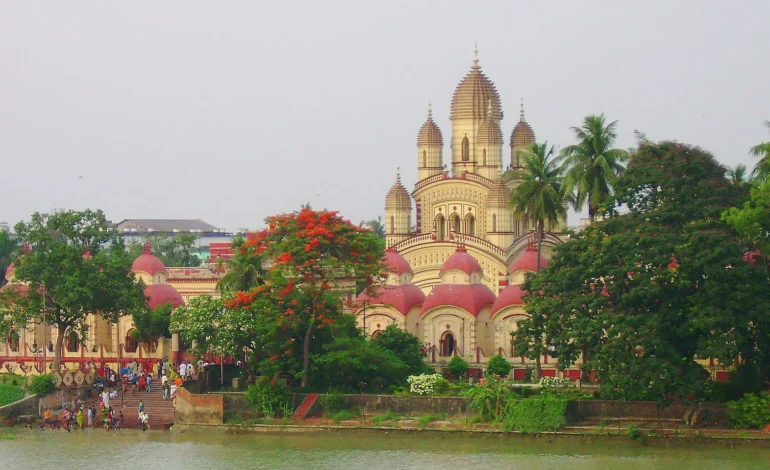
Dakshineswar Kali Temple Kolkata Entry Fee
- No entry fee
Dakshineswar Kali Temple Kolkata Timings
- Monday to Sunday 6 am–12:30 pm & 3:30–7:30 pm
Address: Dakshineswar, Kolkata, West Bengal 700076
Belur Math serves as the headquarters of the Ramakrishna Mission and Math, established by Swami Vivekananda, the chief disciple of Ramakrishna Paramahamsa. Situated on the west bank of the Hooghly River in the Belur area of Howrah city, West Bengal, Belur Math is a prominent landmark in the Kolkata vicinity. The Ramakrishna temple at Belur Math, characterized by a unique blend of Hindu, Islamic, Buddhist, and Christian architectural styles, stands as the focal point of the Ramakrishna movement.
The temple, designed by Swami Vigyanananda following Swami Vivekananda’s initial plans, attracts numerous tourists and devotees as a significant pilgrimage site in India. Belur Math is actively engaged in various social welfare activities, including health services, education, women’s welfare, village development, relief work, and organizing religious and cultural programs for labor and backward classes.
Belur Math commemorates the birth and death anniversaries of Ramakrishna Paramahamsa, Sarada Devi, Swami Vivekananda, and hosts various religious events and Christmas celebrations. During Durga Puja, especially Kumari Puja on Mahashtami, Belur Math welcomes large crowds of visitors and devotees.
In 1897, Swami Vivekananda returned to Colombo after gathering followers from the West. Upon returning to India, he founded two monasteries: the Advaita Ashram at Mayavati in the Himalayas near Almora and the Ramakrishna Mission at Belur near Calcutta. The primary purpose of establishing these monasteries was to receive and train youths interested in joining the Ramakrishna Mission and preparing them for mission work. The Mission’s humanitarian work commenced during a famine in that same year.
During his itinerant life, Swami Vivekananda traveled extensively across India before addressing the Vishwadharma Mahasabha. He visited landmarks such as the Taj Mahal, Fatehpur Sikri, Dewan-i-Khas, Rajputana palaces, and ancient temples in Maharashtra, Gujarat, Tamil Nadu, Karnataka, and other regions. His travels in the United States and Europe exposed him to various architectural styles, including modern, medieval, gothic, and renaissance.
It is believed that Swami Vivekananda planned the architecture of Belur Math by integrating elements from these diverse architectural traditions. Following his vision, his monk-brother and another disciple of Ramakrishna Paramahamsa, Swami Vigyanananda, designed the temple. Vigyanananda, a civil engineer in his previous life, prepared the temple’s design. The foundation stone of the temple was laid on March 16, 1935, and construction was overseen by the renowned engineer and industrialist Sir Rajendranath Mukhopadhyay of Martin Burn and Company. The Ramakrishna Mission describes the temple as an architectural masterpiece that harmoniously blends diverse architectural styles into a unified whole.
The contemporary Dharmasthana at Belur Math integrates diverse architectural elements from temples, mosques, and churches. These architectural features are amalgamated to embody the ideals of universalism espoused by the Ramakrishna movement, making the temple a symbol of religious syncretism.
The main entrance of the temple is designed in a Buddhist style, while the upper section resembles a South Indian temple with tall pillars. Inside, the windows and atrium reflect the architectural styles of Rajput and Mughal traditions from North India. The central dome follows the European Renaissance architectural style, and the interior floor is shaped like a Christian cross, showcasing a blend of various religious influences within the temple’s design.


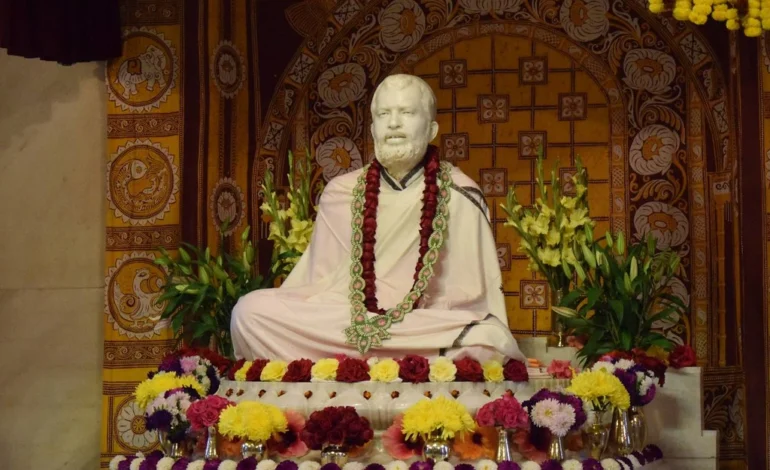
Belur Math Entry Fee
- No entry fee
Belur Math Timings
- Monday to Sunday 8:00 am – 12:00 pm to 3:00 pm – 6:00 pm
Address: Belur, Howrah, West Bengal 711202



